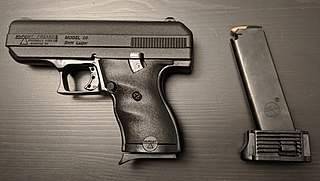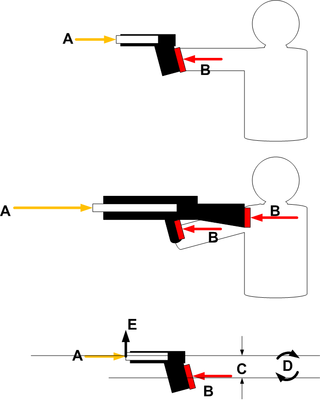
A firearm is any type of gun that uses an explosive charge and is designed to be readily carried and operated by an individual. The term is legally defined further in different countries.

A muzzle brake or recoil compensator is a device connected to, or a feature integral to the construction of, the muzzle or barrel of a firearm or cannon that is intended to redirect a portion of propellant gases to counter recoil and unwanted muzzle rise. Barrels with an integral muzzle brake are often said to be ported.

In firearms terminology, an action is the functional mechanism of a breech-loading firearm that handles the ammunition cartridges, or the method by which that mechanism works. Actions are technically not present on muzzleloaders, as all those are single-shot firearms with a closed off breech with the powder and projectile manually loaded from the muzzle. Instead, the muzzleloader ignition mechanism is referred to as the lock.

A semi-automatic pistol is a handgun that automatically ejects and loads cartridges in its chamber after every shot fired. Only one round of ammunition is fired each time the trigger is pulled, as the pistol's fire control group disconnects the trigger mechanism from the firing pin/striker until the trigger has been released and reset.

Direct impingement is a type of gas operation for a firearm that utilizes gas from a fired cartridge to impart force on the bolt carrier or slide assembly to cycle the action. Firearms using direct impingement are theoretically lighter, more accurate, and less expensive than firearms using cleaner and cooler gas piston systems.
Blowback is a system of operation for self-loading firearms that obtains energy from the motion of the cartridge case as it is pushed to the rear by expanding gas created by the ignition of the propellant charge.

A breechblock is the part of the firearm action that closes the breech of a breech loading weapon before or at the moment of firing. It seals the breech and contains the pressure generated by the ignited propellant. Retracting the breechblock allows the chamber to be loaded with a cartridge.

Gas-operation is a system of operation used to provide energy to operate locked breech, autoloading firearms. In gas-operation, a portion of high-pressure gas from the cartridge being fired is used to power a mechanism to dispose of the spent case and insert a new cartridge into the chamber. Energy from the gas is harnessed through either a port in the barrel or a trap at the muzzle. This high-pressure gas impinges on a surface such as a piston head to provide motion for unlocking of the action, extraction of the spent case, ejection, cocking of the hammer or striker, chambering of a fresh cartridge, and locking of the action.

Locked breech is the design of a breech-reloading firearm's action. This is important in understanding how a self-reloading firearm works. In the simplest terms, the locked breech is one way to slow down the opening of the breech of a self-reloading firearm when fired. The source of power for the movement is recoil.

The Colt Model 1900 is a short-recoil operated "self-loading", or semi-automatic .38 caliber handgun introduced by Colt's Manufacturing Company at the turn of the 20th century. The M1900 was the first firearm to be chambered in .38 ACP and was the first handgun to utilize short-recoil operation.
Limp wristing is a phenomenon commonly encountered by semi-automatic pistol shooters, where the shooter's grip is not firm enough and the wrist is not held firm/straight enough to keep the frame of the firearm from traveling rearward while the bolt or slide of the firearm cycles. This condition often results in a failure to complete the operating cycle, properly termed a malfunction, but commonly termed a "jam". This phenomenon can affect metal or poly framed firearms equally. Both semi-automatic rifles and semi-automatic shotguns, if fired without the stock held against the shoulder correctly, may also be prone to limp wristing. Of the important variables involved in this type of malfunction, bullet and gas momentum, slide and barrel mass, recoil spring pre-load and spring rate, and shooting hand and arm mass are much more important than the compliance (limpness) of the wrist.
A muzzle booster or recoil booster is a device fixed to the muzzle of a firearm, intended to harness the energy of the escaping propellant to augment the force of recoil on portions of the firearm. In spite of its name, a muzzle booster does not increase muzzle force or velocity but instead is usually used to improve the reliability and/or rate of fire of a recoil operated firearm. It was invented by Hiram Maxim in 1894.

The Hi-Point Model C-9 is a polymer-framed, semi-automatic, blowback-operated pistol manufactured by Hi-Point Firearms. It is chambered in 9×19mm Parabellum and is rated to accept +P ammunition. It became well known for its low retail price of under $200. An improved model, the YC9, was originally expected for release by late 2019, but was finally released for sale in August 2023.

A blank-firing adapter or blank-firing attachment (BFA), sometimes called a blank adapter or blank attachment, is a device used in conjunction with blank ammunition for safety reasons, functional reasons or a combination of them both. Blank firing adapters are required for allowing blank ammunition to cycle the bolts of most semi-automatic and automatic firearms. It can also be a safety feature designed to break up the plugs replacing the bullet in military blanks as well as divert the hot gases from a blank discharge out to the sides, reducing the risk of injury to the target of an aimed shot.

The OTs-33 Pernach is a Russian 9x18 Makarov machine pistol, derived from the 5.45 mm OTs-23 Drotik machine pistol. The Pernach is an automatic pistol designed to replace the Stechkin APS in various special OMON units within the Russian police, the Russian Ministry of Internal Affairs (MVD) and other paramilitary units. The OTs-33 was developed in 1995 by Igor Stechkin at the TsKIB SOO design bureau, and it went into limited production at the KBP Instrument Design Bureau. It is also known as the SBZ-2, derived from the names of the KBP team responsible for the pistol, namely Stechkin, Baltser (Бальцер) and Zinchenko (Зинченко).
The following are terms related to firearms and ammunition topics.

Muzzle rise, muzzle flip or muzzle climb refers to the tendency of a firearm's or airgun's muzzle to rise up after firing. It more specifically refers to the seemingly unpredictable "jump" of the firearm's muzzle, caused by combined recoil from multiple shots being fired in quick succession. It has an adverse effect on maintaining accuracy with using automatic weapons or rapid-firing semi-automatic firearms, as a moving muzzle can throw off the shooter's aim, causing subsequent shots to miss the intended target.
Recoil operation is an operating mechanism used to implement locked-breech autoloading firearms. Recoil operated firearms use the energy of recoil to cycle the action, as opposed to gas operation or blowback operation using the pressure of the propellant gas.

The SIG Sauer system is a type of action found in self-loading handguns. It is a refinement of designs based on the work of both John M. Browning and Charles Petter which began with the Colt Model 1900, progressed to the French Model 1935A, and later the SIG P210 handgun. This action first appeared in the United States on the Browning BDA .45 ACP caliber handgun around 1975. It represents a design which optimizes the cost of production of handguns while instilling high levels of accuracy and dependability. It is the basis for several SIG Sauer, Inc. designs which have been widely adopted for police, military, and civilian use and is the action used in the M17 and M18 sidearms of the United States Armed Forces. It has become a highly copied design found in many parts of the world today.

A repeating firearm or repeater is any firearm that is capable of being fired repeatedly before having to be manually reloaded with new ammunition from the magazine.

















